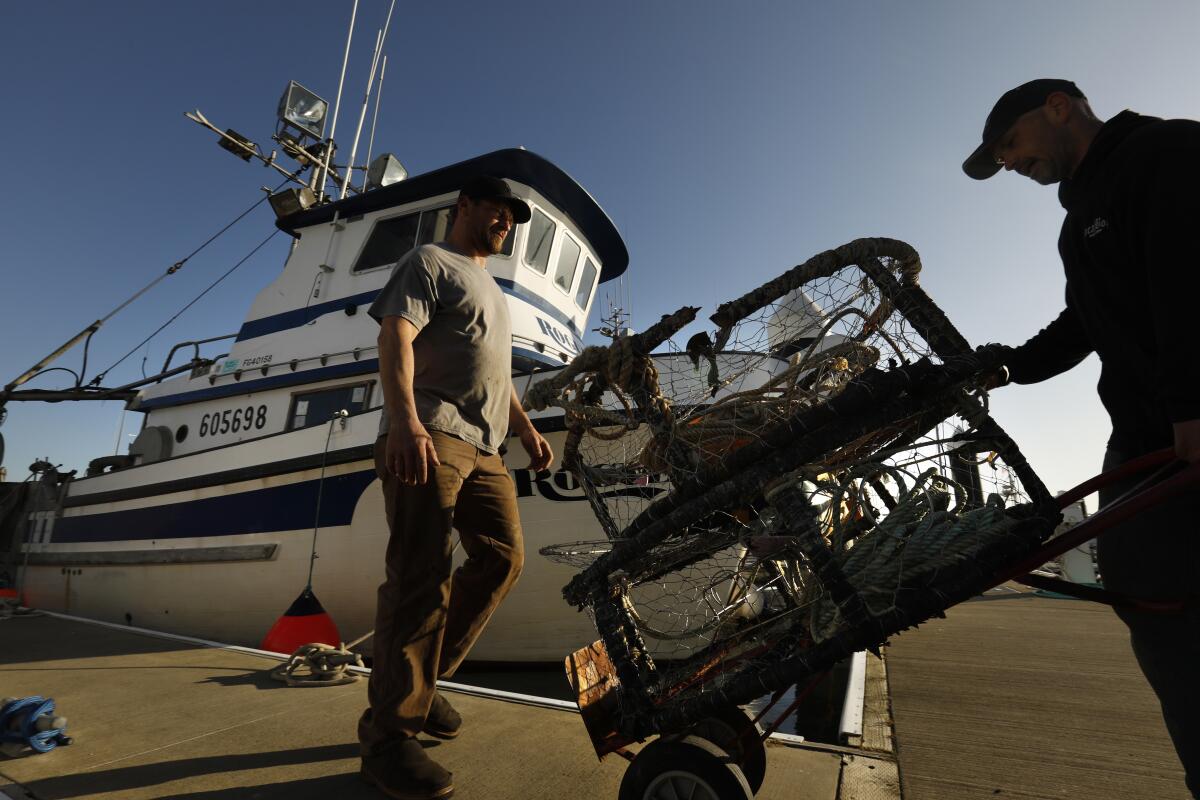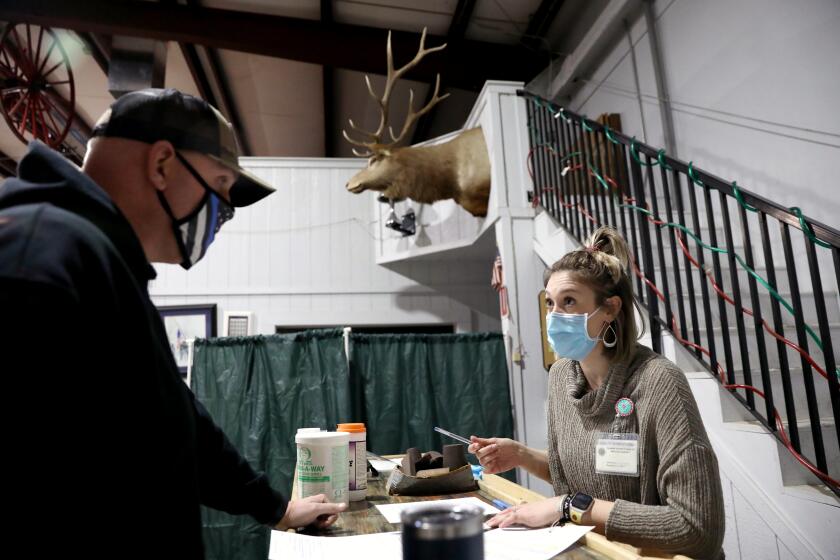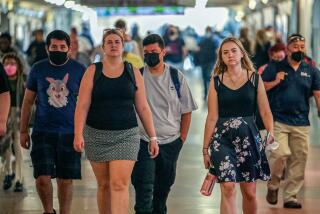Mortuaries fill, hospitals clog in rural California towns with low vaccination rates

In Crescent City, the mortuary is filled beyond capacity and needs a refrigerated truck to hold bodies. The small hospital is so full that it is lining up helicopters to fly COVID-19 patients out of remote Del Norte County. So many employees are out with coronavirus infections that businesses have closed.
Deaths in Del Norte County from COVID-19 have more than doubled in recent weeks, from 10 on Aug. 15 to 22 on Friday. Four people died in a single day, officials said.
A year and a half into the pandemic — and eight months since highly effective vaccines became available — COVID-19 is surging across rural California, where inoculation rates are low, more intensely than it ever has before.
Del Norte County health officials believe there is an undercount in the number of people who have died from COVID-19 and that some never made it to the hospital. The coroner is investigating.
“This has been our worst fear,” State Sen. Mike McGuire (D-Healdsburg), who represents seven counties stretching from Marin to Del Norte, told The Times. “We saw significant surges in urban areas in this state early on. Now, rural California is the epicenter for this pandemic.”
Health officials and hospital administrators have long feared a coronavirus surge in vast, sparsely populated Northern California, where there was already a shortage of doctors and where an emergency from trauma or illness can mean an hours-long drive to the nearest medical facility.
In August, nine Northern California counties have seen more patients hospitalized with COVID-19 than at any other point in the pandemic: Amador, Del Norte, Humboldt, Lake, Mendocino, Placer, Plumas, Shasta and Tuolumne.
In the state’s conservative northern reaches, health officials have battled against widespread distrust of the vaccines, skepticism about the virus and anger over mask mandates and lockdowns. The region’s dramatic spike in cases attributed to the highly contagious Delta variant mirrors what is happening across the country in states that supported President Trump, who acknowledged that he deliberately downplayed the danger of the coronavirus early last year.
“We have spent too much time fighting each other and not fighting the virus,” McGuire said. “Unfortunately, politics has ruled the day. We need the public’s health to come first.”
Perhaps nowhere in California is the disaster more acute than in Del Norte County in the remote northwest corner, where the redwood forest meets the sea. Cumulative coronavirus cases have more than doubled over the last three months, from 1,380 confirmed on May 10 to 2,805 on Friday. At least 70 cases were confirmed Thursday alone.
The county of 27,800 people has one hospital, the 49-bed Sutter Coast Hospital in Crescent City. The next-closest in California is a 90-minute drive south in Humboldt County — over a stretch of Highway 101 called Last Chance Grade that is crumbling into the sea.

The state has sent extra doctors, nurses, X-ray technicians and respiratory therapists to the overwhelmed Sutter Coast Hospital, and 40 ventilators have been ordered, McGuire said.
Typically during this time of year, there are 20 to 25 patients at Sutter Coast, Chief Executive Mitch Hanna said during a virtual town hall Thursday night. That day, there were 36 patients, 22 with COVID-19. Eight of the nine beds in the intensive care unit were full, Hanna said. The hospital has been modifying other units to make room for additional ICU patients. Two tents stand outside: one for triage; the other, filled with beds, for surge capacity. Non-emergency surgeries are being postponed.
Like many facilities in rural regions, where it can be hard to recruit professionals, Sutter Coast struggled with staffing shortages even before the pandemic. Now, Hanna said, that deficit is exacerbated by doctors and nurses falling ill with the virus.
“They’re tired,” Hanna said of the staff. “Many of them are pulling double shifts and lots of overtime.” He does not expect the surge to peak for two to four weeks.
In rural Northern California, small public health departments battle COVID-19 in a region where skepticism of the virus runs deep.
On average, Hanna said, 83% of the hospital’s new COVID-19 patients have been unvaccinated. In Del Norte County, 35.8% of the population is fully vaccinated, compared with 56.3% of all Californians, according to The Times’ vaccine tracker.
Earlier this month, more than 100 doctors in Del Norte and neighboring Humboldt County signed a letter pleading for residents to get vaccinated.
“As your physicians, and as the people with whom you have worked, played, laughed and cried, we must admit we are tired,” it said. “We will keep working, of course. But we are tired. We are tired of the suffering, pain and death that can be avoided by getting vaccinated.”
Dr. Aaron Stutz, the Del Norte County public health officer and an emergency room physician at Sutter Coast, told The Times this week that he has treated numerous COVID-19 patients who said they “were really upset, wishing they had gotten the vaccine before they went to the ICU.” But he has also had unvaccinated patients who regret nothing, “sticking to their guns, adamant,” he said.
It’s “a bummer” to see this surge so many months into the pandemic, he added. “There’s a lot of frustration in the community, people wondering why we are spending so many resources on this situation and a lot of outcry in healthcare, asking why we’re being expected to deal with this when people can get a vaccine and it’s potentially treatable.”

Stutz said he views COVID-19 like other diseases “where somebody’s lifestyle has an effect.” People still smoke and get lung cancer, he said, and “we still help them when they need help.”
On Thursday, Stutz issued a countywide mandate, requiring masks in indoor public spaces and crowded outdoor spaces, regardless of vaccination status. Trinity County — which has no ICU beds and 37.5% of residents fully vaccinated — also issued a mask mandate Thursday.
During the Del Norte County town hall Thursday, commenters claimed that masks are ineffective and dangerously reduce the wearer’s oxygen levels — myths that scientists have debunked.
“I’m going to be candid: That’s B.S.,” McGuire responded. “So, let’s talk about the facts.”
Stutz noted that he uses machines that measure carbon dioxide and oxygen levels during every shift, and masks have no ill effects. “They’re not harmful,” he said. “If you’re going to strap a hundred masks on your face? OK, maybe then.”
Democratic legislators believe mandates could improve vaccination rates and help lessen the effects of the Delta variant spreading in California.
Blake Inscore — mayor pro tem of Crescent City, the Del Norte County seat, with a population of 6,800 — addressed Zoom questions about who was going to enforce the mask mandate, his frustration palpable.
“You are!” he said. “You’re going to enforce it. You make the conscious decision yourself to do the responsible thing for you, for your neighbors and for the people in this community.
“We shouldn’t have to have somebody managing a mask mandate. We shouldn’t put that on a server in a restaurant who’s going to get hassled. Take responsibility, Del Norte County and Crescent City.”
Inscore said that when the surge began and he was encouraging people to take it seriously, he spoke to someone who referenced the fabled boy who cried wolf.
“‘You told us to do all these things last year, and it never materialized,’” Inscore said the person told him. “‘Why should we believe you now?’ Well, I’ll tell you why you should believe us now: because the wolf is here.”
In Crescent City, the vast majority of calls to the fire department involve people suspected of having COVID-19, said City Manager Eric Wier, and resources are strained, putting the community at risk in the face of other potential emergencies.
His family ran Wier’s Mortuary Chapel for decades before recently selling it. The new owner told him this week that the mortuary is beyond capacity.
“These aren’t numbers,” Wier said. “These are families. These are our neighbors. These are our friends. That’s who we’re talking about here.”
Times staff writer Sean Greene contributed to this report.
More to Read
Start your day right
Sign up for Essential California for news, features and recommendations from the L.A. Times and beyond in your inbox six days a week.
You may occasionally receive promotional content from the Los Angeles Times.









